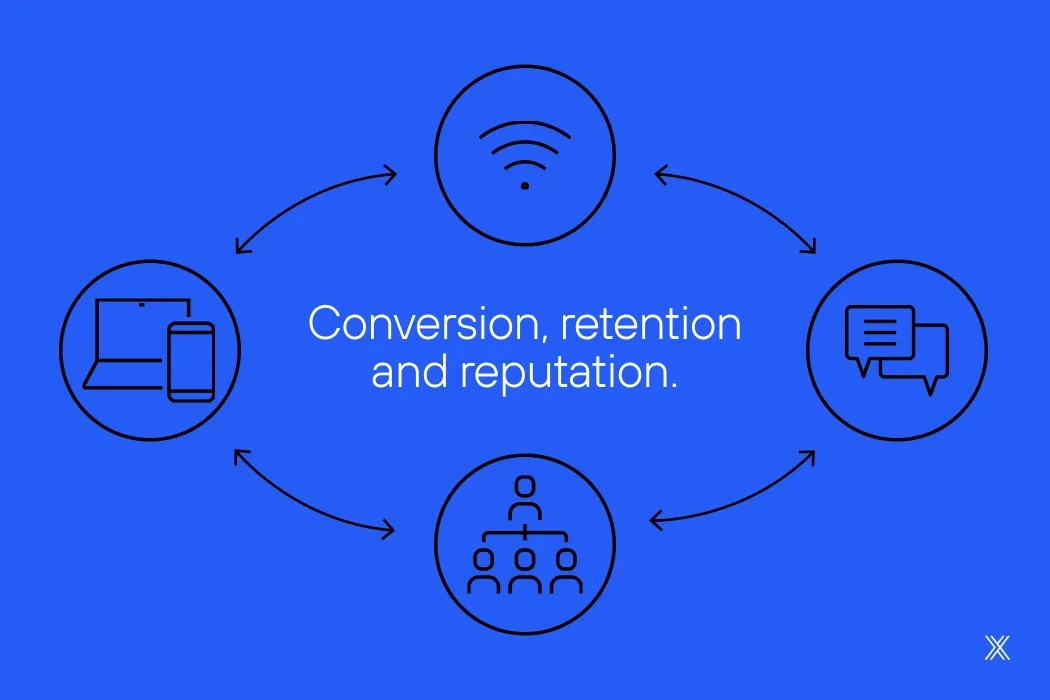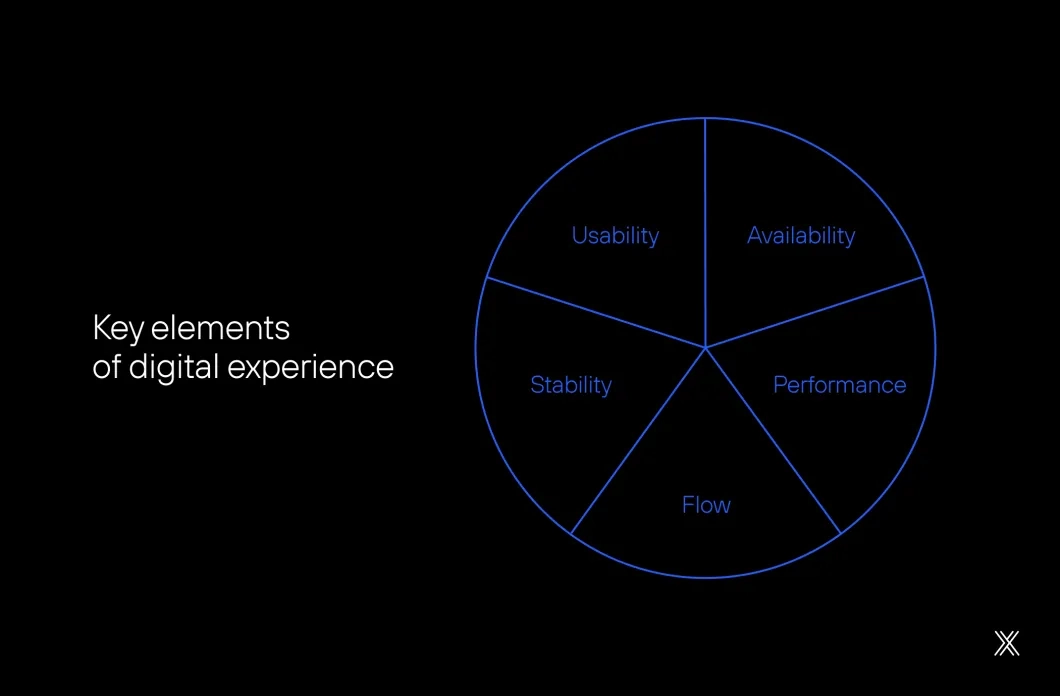
The best digital customer experience (DCX) is so seamless and intuitive that users don’t even notice the effort behind it. It feels like following a well-marked path that guides you smoothly to your goal. But a single technical issue or usability flaw can break the flow and turn what was once simple into frustration.
Delivering a strong DCX goes beyond visual design. Every interaction should reflect the quality, consistency, and relevance your audience expects. After all, it’s in those interactions that customers decide whether to stay with your brand or move on.
In this article, we’ll dive into what makes a digital customer experience truly effective and why it’s such a critical lever for business growth.
What is digital customer experience?
Digital customer experience (DCX) is a core branch of digital experience (DX), focused specifically on how customers interact with a brand across digital touchpoints. While DX covers the overall design and performance of platforms, DCX zeroes in on the customer journey — ensuring it’s efficient, intuitive, and rewarding.
Examples of DCX touchpoints include websites, mobile apps, e-commerce, customer portals, support interfaces, and social channels. And it’s not just about looks. A good DCX depends on technical decisions that ultimately determine whether customers can accomplish their goals or drop off mid-process.
Here are some of the key elements behind a high-performing digital customer experience:

- Availability: your system must be accessible whenever the customer needs it.
- Performance: pages and apps should load quickly and respond without delay.
- Flow: the customer journey should be clear, with well-defined paths and no unnecessary steps.
- Stability: your application should run consistently without recurring errors or crashes.
- Usability: customers should easily find what they’re looking for without needing to adapt to the interface.
When these elements work in sync, your business gains the ability to monitor, optimize, and scale its digital presence using real-time data. That means fewer friction points, better retention, and a stronger perception of value.
Want to talk to a DX specialist? Let’s connect
Why digital customer experience should be a business priority
Companies that treat DCX as a strategic extension of DX, not just a design layer, reduce costs, improve business metrics, and boost operational efficiency.
Enhancing DCX impacts multiple areas of business success:
- Higher conversion rates: intuitive interactions make it easier for customers to purchase, subscribe, or complete tasks.
- Operational efficiency: smoother journeys reduce support tickets and rework, freeing teams to focus on growth.
- Customer retention: frictionless experiences lower churn and strengthen long-term loyalty.
- Lower acquisition costs: optimized customer experiences make marketing spend more effective, improving ROI.
In short, investing in DCX ensures that DX delivers real value. Customers feel understood and supported, while companies build stronger relationships and grow more sustainably.
Technical foundations for scalable digital customer experiences
Delivering a consistent DCX requires well-structured decisions across multiple layers of your solution. Below are the key principles that support high-performing, scalable platforms built for security, speed, and relevance.
User-centered design
Designing based on real customer data and usability testing ensures the interface meets specific needs. This leads to fewer errors, better adoption, and more efficient interactions.
Usability
Interfaces should be clear, consistent, and easy to use. Good UX minimizes unnecessary clicks and accelerates task completion. This directly affects metrics like conversion and time-on-site.
Accessibility
Following accessibility standards such as WCAG is essential to ensure your platform works for all customers. Features like proper contrast, keyboard navigation, and screen reader support expand reach and eliminate usage barriers.
Consistency
Standardizing visual elements, tone, and interactions reduces cognitive load and makes it easier for customers to learn how to navigate. This is especially important in systems with multiple user journeys, features, or personas.
Contextual personalization
Tailoring the experience based on customer profile, device, or journey stage increases the relevance of interactions. This includes responsive layouts, personalized content, and functionality adapted to specific contexts.
Performance
Speed and stability are critical to perceived quality. It's essential to optimize page load time, resource usage, and API responsiveness using techniques like lazy loading, caching, and file compression.
Evolution-ready value
Platforms need to be adaptable. That means collecting usage data, running controlled experiments, and continuously delivering improvements based on real metrics. A system that evolves quickly remains effective over time.
These foundational pillars form the technical backbone of scalable, secure, customer-first digital experiences. In the next section, we’ll explore how platforms like Drupal support this model in complex projects.
Also read: Creating Impactful Digital Experiences: 7 Core Principles →
How to evolve your DCX in practice
Improving DCX doesn’t mean starting from scratch. The smartest path is identifying current friction points, understanding customer behavior, and implementing improvements incrementally, all based on real data.
Here are a few practical actions that can take your digital customer experience to the next level:
Invest in responsive design
Your layout needs to work effectively across all devices. Poor responsiveness directly hurts conversions and credibility. A responsive design not only improves usability but also signals your commitment to accessibility and modern standards.
Simplify navigation
Clear menus, effective search tools, and a well-defined visual hierarchy help customers find what they need quickly and intuitively.
Use data to personalize
Analyzing customer behavior, preferences, and history allows you to adapt content, offers, and functionality for each profile. The more tailored the experience, the higher the engagement.
Optimize performance
Reducing load times, resolving technical bottlenecks, and monitoring critical APIs should be top priorities. A fast, seamless experience not only retains visitors but also boosts visibility in search results.
Collect and analyze feedback
Quick surveys, heatmaps, and A/B tests are key to understanding what’s working and what needs refinement. DCX evolves through active listening and rapid iteration.
Want to talk to a DX expert? Let’s connect
The role of a DXP in DCX
A Digital Experience Platform (DXP) is an integrated solution that enables companies to manage and optimize customer experiences across digital channels. It brings together content management, personalization, analytics, and channel integration to deliver cohesive, data-driven interactions.
Its core role is to centralize everything from the content a customer sees to the way their behavior is tracked and analyzed. This makes the experience feel consistent and relevant, as if the brand knows exactly what they need.
With that intelligence, you can serve the right content at the right time. The result is stronger engagement and a deeper connection with the brand.
Examples of DXP Platforms
- Adobe Experience Manager: content management, personalization, and analytics for immersive DCX;
- Sitecore: advanced personalization and content capabilities for data-driven interactions;
- Acquia: built on Drupal, with strong content management and analytics tools;
- Liferay: focused on portals and collaboration, integrating multiple channels;
- Optimizely (Episerver): merging content and commerce to optimize the customer journey.
Also read: DXP vs CMS – key differences and how to choose →
Why Drupal Might Be the Right Fit
Drupal, the open-source platform behind Acquia, is designed for organizations that require complete control over their digital architecture, content structure, and integrations. It provides a robust technical foundation for complex, customer-facing projects.
Here are some of its key strengths:
- Advanced content modeling: custom content types, reusable fields, and configurable workflows;
- API and legacy system integration: connect to CRMs, CDPs, analytics tools, and marketing platforms;
- Support for headless and composable architecture: deliver content flexibly across multiple channels;
- Built-in multilingual support: ideal for global DCX;
- Enterprise-grade security: backed by frequent updates and an active developer community;
- Scalability: reliable in high-traffic environments and multisite ecosystems.
At Dexa, we specialize in Drupal. Our focus is on building stable, enterprise-ready solutions that grow with your business and align with your digital strategy. For us, digital customer experience is not a layer, it's the foundation.
Want to learn more? Speak with a Drupal expert today.
